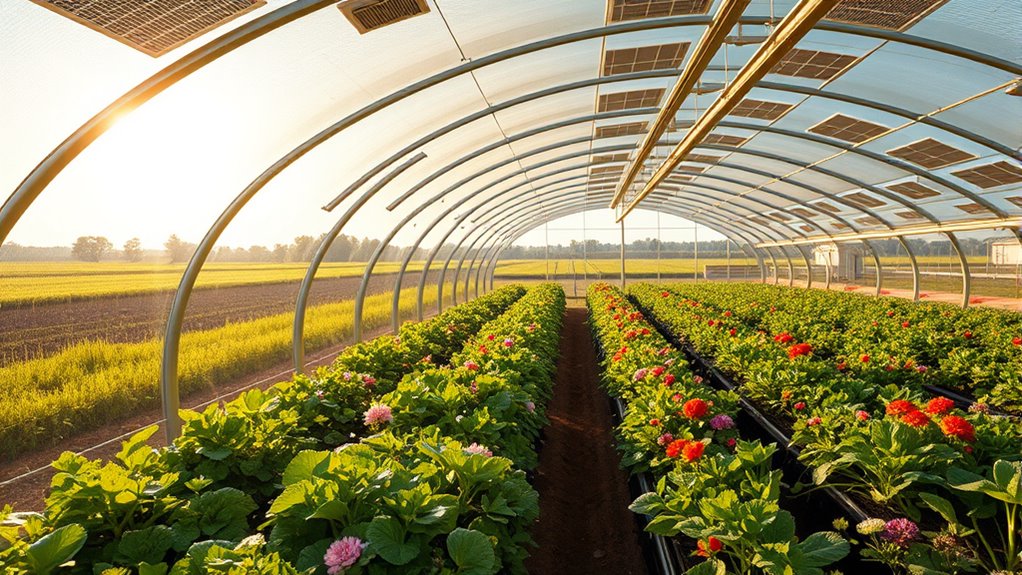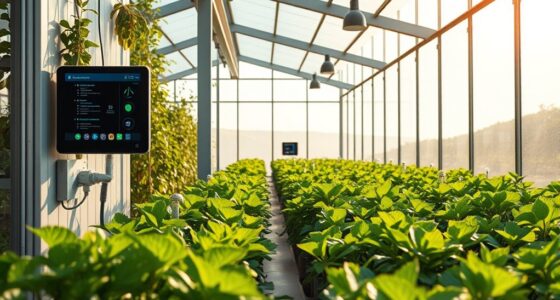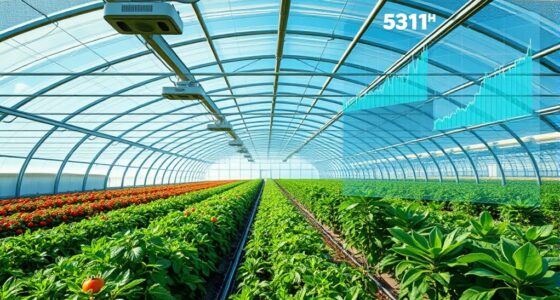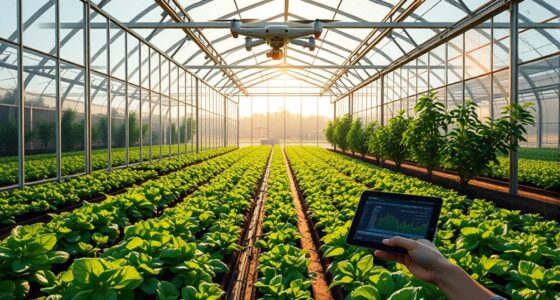Using solar energy to power greenhouses allows you to create a controlled environment while dramatically cutting energy costs. You can harness free, renewable sunlight to maintain ideal growing conditions for a variety of crops, from leafy greens to tomatoes. Regularly maintaining your solar panels ensures they operate at peak efficiency. By carefully selecting crops and planning for seasonal changes, you can maximize productivity year-round. Keep exploring to discover how to enhance your solar-powered farming system further.
Key Takeaways
- Solar-powered greenhouses harness free solar energy to create controlled growing environments, reducing operational costs.
- Regular maintenance of solar panels ensures maximum efficiency and continuous energy supply for greenhouse operations.
- Selecting crops suited for solar environments, like leafy greens and herbs, optimizes growth and yields.
- Seasonal adjustments and environmental monitoring help maintain productivity year-round despite weather changes.
- Integrating solar energy management with crop planning promotes sustainable, eco-friendly farming practices.

As the world seeks sustainable ways to grow food, solar-powered greenhouses are gaining popularity for their eco-friendly approach. These structures harness the sun’s energy to create a controlled environment for cultivating crops, reducing reliance on fossil fuels and lowering operational costs. However, to maximize their benefits, you need to stay on top of solar panel maintenance. Regularly checking for dirt, dust, or debris that can block sunlight guarantees your panels operate at peak efficiency. Periodic inspections help identify potential issues early, such as loose wiring or damaged components, which could impair energy collection. Keeping your solar panels clean and well-maintained certifies you get the most out of the free energy provided by the sun, directly impacting your greenhouse’s productivity and sustainability.
In addition, understanding the best anime movies can inspire creativity and innovation in your agricultural projects by highlighting diverse storytelling and visual techniques. While focusing on solar panel maintenance, you should also pay close attention to greenhouse crop selection. Not all plants thrive equally in a solar-powered environment, so choosing suitable crops is essential for maximizing yields. Consider plants that are well-adapted to the specific light and temperature conditions your greenhouse offers. Leafy greens like lettuce, spinach, and herbs tend to be excellent choices because they grow quickly and require less intensive energy input. Root vegetables or fruits like tomatoes and peppers can also be successful if the greenhouse maintains consistent temperature and humidity levels. By selecting crops that suit your greenhouse’s environment, you optimize space and resources, ensuring a steady harvest that justifies your investment in solar technology.
Integrating solar panel maintenance with thoughtful crop selection makes your greenhouse operation more sustainable and profitable. As you monitor your solar panels, you’ll learn how weather patterns and seasonal changes affect energy collection, allowing you to adapt your crop choices accordingly. For example, during cloudy months or in winter, you might prioritize hardier crops that can tolerate lower light levels, or adjust your heating and ventilation systems accordingly. This proactive approach ensures your greenhouse remains productive year-round, even when sunlight is less abundant.
In addition, managing your greenhouse crop selection can help you plan for energy consumption needs, making the most of the solar energy you generate. By aligning your crop planting schedule with your solar energy output, you can reduce reliance on backup power sources and lower costs. Regularly inspecting and maintaining your solar panels becomes part of this holistic strategy, ensuring your entire system works seamlessly. This way, you turn your greenhouse into an efficient, eco-friendly operation that leverages free solar energy without sacrificing crop quality or yield.
Frequently Asked Questions
What Are the Initial Costs of Setting up a Solar-Powered Greenhouse?
The initial investment for setting up a solar-powered greenhouse can vary widely depending on size, location, and technology choices. You might spend more upfront on solar panels, batteries, and installation costs. However, financing options like loans or grants can help reduce your immediate expenses. Keep in mind that while the initial costs are significant, the long-term savings on energy bills make it a worthwhile investment for sustainable farming.
How Much Maintenance Is Required for Solar Panels in Greenhouses?
You’ll find that maintaining solar panels in greenhouses is manageable. Regular panel cleaning is essential to keep efficiency high, typically every 6 to 12 months, depending on dust and dirt levels. Inverter maintenance is also necessary; check for error messages and ensure connections stay secure. Overall, with routine inspections and cleaning, your solar system will perform reliably, providing clean energy to power your greenhouse effectively.
Can Solar Greenhouses Operate Effectively in Low Sunlight Regions?
Imagine a lighthouse guiding ships through foggy waters; that’s how solar radiation can shine even in low sunlight regions. Your solar greenhouse can still operate effectively, harnessing diffuse sunlight to power your crops. While sunlight’s strength affects crop yield, modern solar technology maximizes energy capture, ensuring your plants thrive. So, even in less sunny areas, your greenhouse can flourish by making the most of available solar radiation.
What Are the Environmental Impacts of Installing Solar Panels on Greenhouses?
Installing solar panels on greenhouses reduces reliance on fossil fuels, helping cut greenhouse gas emissions. This promotes biodiversity preservation by maintaining natural habitats and improving air quality. However, you should consider potential impacts on soil health, as installation can disturb land and soil structure. If managed carefully, solar panels can support sustainable farming practices, balancing energy needs with environmental protection, and fostering a healthier ecosystem around your greenhouse.
How Do Solar-Powered Greenhouses Compare Financially to Traditional Greenhouses?
You’ll find that solar-powered greenhouses often save you money over traditional ones thanks to lower energy costs. Solar panel durability guarantees they last many years, providing steady energy savings. Although initial setup can be higher, the long-term financial benefits are significant, with reduced utility bills and potential government incentives. Over time, these greenhouses become a smarter, more sustainable investment, helping you cut costs while supporting eco-friendly farming.
Conclusion
So, here’s the irony: while solar-powered greenhouses harness free energy from the sun, you might still find yourself paying hefty bills for heating and equipment. It’s almost funny how nature’s gift isn’t entirely free from costs. But hey, at least you’re doing your part for the environment, right? Just remember, even green energy has its quirks—so enjoy your eco-friendly farming, and don’t forget to smile at the little irony in it all.









